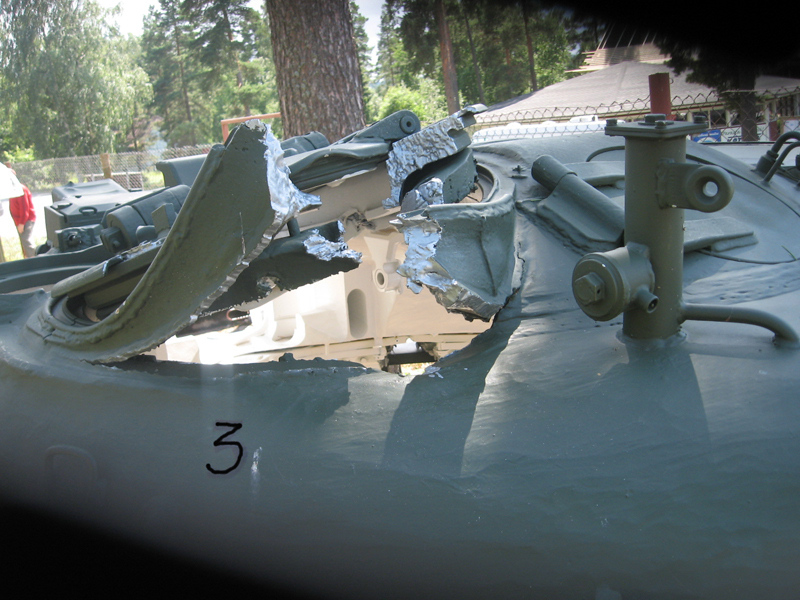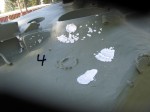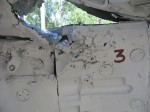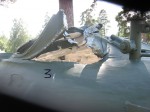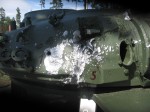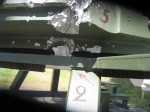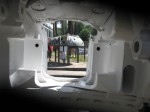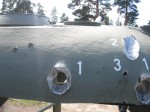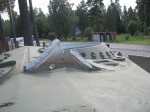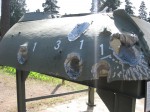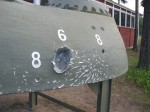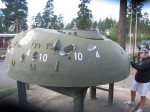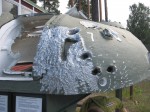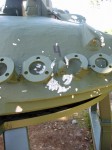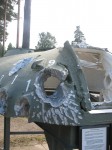1⁄1Shell Impact
7
Comments
Description of impacts and penetrations
1. Main Battle Tank T55 100mm armour piercing round (100 APCBC). Hit and penetration (4pcs). 2. Main Battle Tank T55 100mm armour piercing round (100 APCBC). Hit, no penetration due to small angle of impact. 3. Light recoilless rifle (55S55) of Finnish origin, Two hits and penetrations. Note the small penetration of the HEAT (High Explosive Antitank) jet in comparison to the kinetic ammunition (Armour Piercing, POS.1) Note also the residual penetration of the upper impact on the opposing turret wall. 4. And 10 several hits and penetrations of 57mm armour piercing rounds. The gun has been used as a double cannon installation in the anti aircraft tank SU-57-2. some rounds have inflicted a bigger penetration hole than the calibre due to the breaking of the armour. A small angle of impact has caused a ricochet in one case. 5. Typical impacts of different High Explosive Fragmentation shells. The lower one is a hit by a 57mm (HE) shell. The upper one is a hit by a 100mm (HE) shell, no penetration has occurred. The larger calibre hit has caused a breakage of the welding seams between the rear wall and roof armour of the turret. 6. Two hits by 57mm Armour Piercing ammunition, no penetration due to the armour thickness and small angle of impact. 7. Several hits by 100mm tank gun HEAT rounds. Note a much larger penetration hole in comparison to the recoilless rifle HEAT penetrations (Position 3 and 8), tracks left on the surface by the fragments and impact of the shells stabilizing wings. 8. two hits and penetrations by the recoilless rifle HEAT ammunition. Note the small penetration hole of the HEAT jet in comparison to the kinetic ammunition (Armour piercing POS.1). Note also the rear portion of the HEAT jet which after penetration has been left to the penetration hole and the fragmentation effect of the shell around the penetration hole. 9. Hit by the 100mm tank gun HEAT ammunition directly to the penetration hole left by the 100mm kinetic armour piercing round. Note the impact of the stabilizing wings of the shell around the impact hole.Comments
Pat- I think this will prove really useful to a lot of modellers out there. Thanks!
JUL 18, 2011 - 02:58 AM
Very nice feature, Pat. excellent reference for the upcoming "knocked out" campaign.
Allow me to supplement with a couple of Pictures from Latrun tank museum in Israel. As I recall the pictures show the impact of Sagger AT missiles, but my hebrew is a little rusty
Thanks for sharing




JUL 21, 2011 - 05:10 AM
Darren I somehow missed that you had added this last week- thanks
It should be Finnish perspective as all the shots are from the anti tank section of the Parola Panzer Museum in Finland.
Bill sorry for the late reply as I said above these are from the Parola Tank museum. I didn't take a shot of my favourite exhibit however which was a birch log about two foot long. Yo use in an anti tank capacity you jam it in the tank threads and then shoot the crew when they come out to see what's jamming the tracks
JUL 24, 2011 - 11:50 AM
very interesting feature. I was fascinated by the diffrence of impact / penetration of APCBC and HEAT.
JUL 24, 2011 - 10:17 PM
the upper hit is the AT-missile, the lower is an AP ammunition - i think some kind of APFSDS
JUL 24, 2011 - 10:20 PM
Copyright ©2021 by Pat McGrath. Images and/or videos also by copyright holder unless otherwise noted. The views and opinions expressed herein are solely the views and opinions of the authors and/or contributors to this Web site and do not necessarily represent the views and/or opinions of Armorama, KitMaker Network, or Silver Star Enterrpises. All rights reserved. Originally published on: 2011-07-18 00:00:00. Unique Reads: 22205




